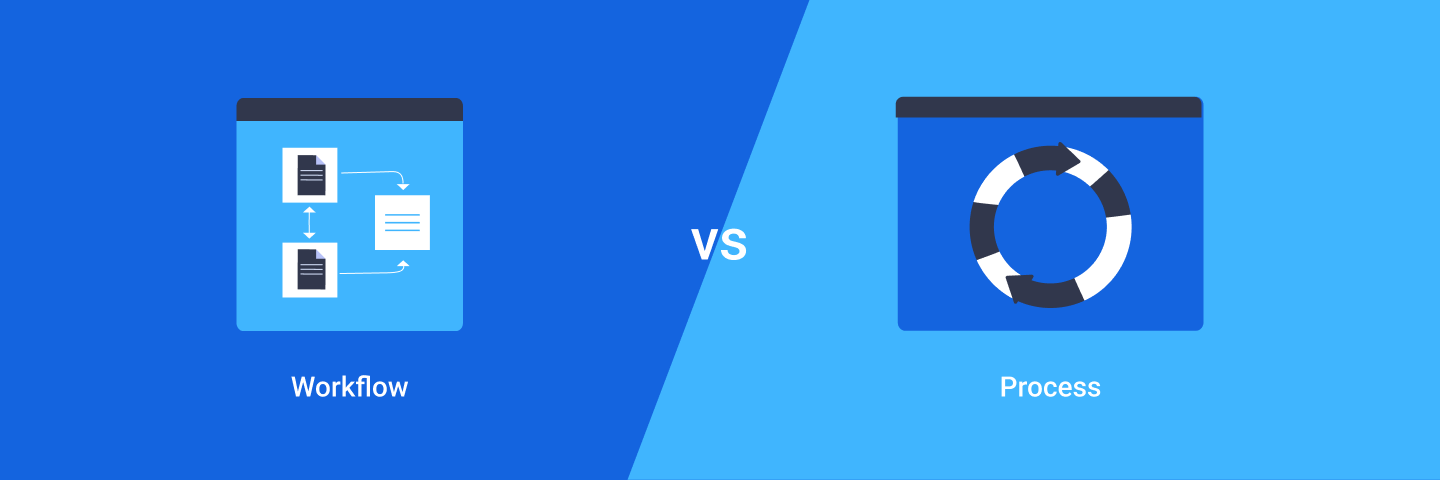Workflow Automation Vs. Process Automation: What’s the difference?
Process automation is a field that is & always will be subject to constant evolution. Organizations constantly seek ways to automate business processes to improve efficiency and enhance productivity. Two key approaches that have gained prominence in this pursuit are workflow automation and process automation. While these terms often are used interchangeably, it is crucial to understand their nuances and distinct benefits to make informed decisions regarding implementation. Both offer unique solutions to tackle operational challenges but mainly differ in scope and focus. By understanding the distinctions between them, organizations can decide which approach best aligns with their specific needs and objectives.
What Is Workflow And Process?
Before diving in detail, let’s briefly discuss workflow and process.
A workflow refers to a series of steps or tasks executed in a specific order to achieve a desired outcome or goal. It outlines the sequence of activities, the dependencies between them, and the individuals or roles responsible for carrying out each task.
A process is a series of actions, tasks, or steps performed to achieve a specific objective or outcome. Processes are systematic and structured in nature, often involving a set of inputs, activities or transformations, and outputs.
Workflow Automation
Workflow automation uses technology and software to automate business processes. It involves creating a series of actions or steps to be executed automatically, reducing the need for manual intervention, and improving efficiency.
Workflow automation typically involves defining the sequence of activities, setting up rules and conditions, and using software tools to automate the movement of information, documents, or tasks from one person to another in a predefined order. It often includes notifications, reminders, and escalations to ensure the timely completion of tasks. Some advantages of using workflow automation include increased efficiency, improved accuracy, faster turnaround time, enhanced collaboration, scalability, compliance, and auditability. Workflow automation can be applied to various use cases across different industries, including but not limited to customer onboarding, purchase order processing, invoice processing, data entry and validation, marketing campaign management, content publishing, etc
Process Automation
On the other hand, process automation is a broader concept encompassing the automation of entire business processes or workflows. It focuses on automating end-to-end processes that involve multiple interconnected tasks, systems, and stakeholders. It aims to optimize and streamline the overall operation of a business process rather than just individual tasks within it.
It involves analyzing, mapping, and redesigning the entire process to eliminate inefficiencies, bottlenecks, and manual interventions. It often involves integrating disparate systems, applications, or data sources to enable seamless data flow and coordination across the process. It may leverage RPA, business process management (BPM) software, or intelligent automation tools to automate complex, cross-functional processes.
Among the several benefits that it offer include increased efficiency, time savings, cost reduction, improved accuracy and quality, enhanced scalability, better customer experience, data-driven insights, and employee satisfaction. It can be applied to a wide range of use cases across various business functions and industries. Some of these include invoice processing, data entry, and data integration, report generation, IT services management, human resource management, sales and marketing, supply chain management, quality control and testing, customer support and helpdesk, contract management, and healthcare processes, to name a few.
Differences

The benefits of both of them do overlap to a certain extent. Still, they offer a different set of components that should be considered while selecting either of the approaches. Here are the key differences between them:
Scope
Workflow automation focuses on automating the sequence and execution of tasks or activities within a defined process or workflow. It deals with the automation of individual steps or actions within a process. Conversely, process automation encompasses the automation of entire end-to-end business processes, including multiple interconnected tasks, systems, and stakeholders.
Level of Automation
Workflow automation primarily targets the automation of routine and repetitive tasks within a process. It aims to streamline workflow, improve efficiency, and reduce manual effort by automating specific actions or steps. Conversely, process automation seeks to automate the entire process, eliminating manual interventions and optimizing the overall operation. It involves the automation of both routine and complex tasks within a process.
Focus
Workflow automation is focused on the movement of tasks, activities, and information within a process or workflow. It aims to ensure that work is routed, assigned, and completed efficiently and in the correct order. Process automation focuses on optimizing the overall process flow, identifying bottlenecks, and eliminating inefficiencies across the entire process. It looks at the bigger picture and aims to achieve holistic process improvements.
Integration
Workflow automation typically involves integrating software tools or systems to automate the flow of tasks and information between individuals or departments. It often includes notifications, reminders, and escalations to facilitate collaboration and timely completion of tasks. Process automation goes beyond individual tool integrations and may involve integrating multiple systems, applications, or data sources to enable end-to-end automation. It aims to create a seamless flow of data and coordination across the entire process.
Complexity
Workflow automation tends to be simpler and more focused on specific tasks or actions. It may involve straightforward rules or conditions to automate task routing or assignment. >Process automation, on the other hand, deals with complex business processes that may span across different departments, systems, or stakeholders. It often requires more advanced automation technologies and techniques, such as RPA or BPM software, to handle the complexity of interconnected tasks and systems.
Workflow Automation Vs. Process Automation Conclusion
Workflow automation targets the automation of individual tasks within a process, while process automation aims to automate entire end-to-end processes involving multiple tasks, systems, and stakeholders. Process automation has a broader scope, focuses on overall process optimization, and often requires more advanced integration and automation techniques.
Ultimately, the choice between them depends on your automation goals’ specific objectives, complexity, and scale. It may even be a combination of both approaches, starting with workflow automation in specific areas and gradually expanding to process automation as your needs evolve.